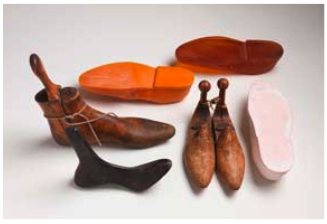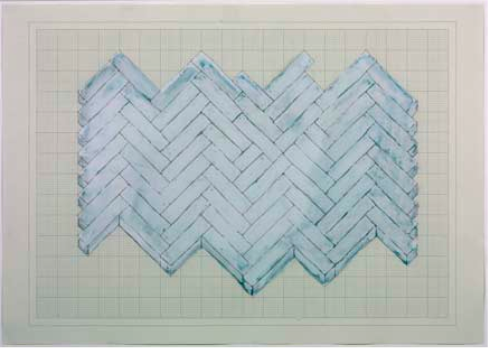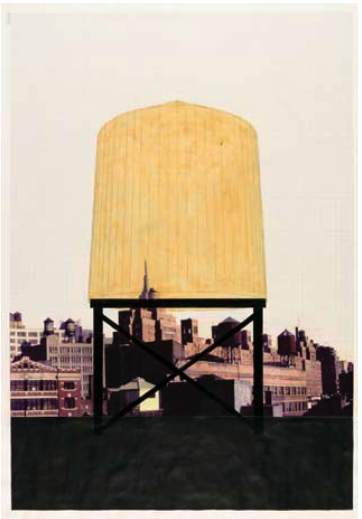Allegra Pesenti and I met at a dinner for the opening of a contemporary artist's work sponsored by a magazine. She was seated next to the artist; I next to the editor. Both of us in our respective hot seats, as it were. Though I've known many curators, I could sense she too felt something of the awkwardness that the merging of art and commerce sometimes produces. Pesenti, a comely, vibrant Italian who grew up in England and was previously at the Getty--and who is experienced at navigating the delicate minefields of personal relationships between artists and curators--has convinced Rachel Whiteread to take her drawings out of the closet for their very first exhibition in Los Angeles at the Hammer Museum. She here illuminates for us something of the behind the scenes process in putting together an exhibition that is a collaboration between a living artist and a curator who wants to advance the conversation.
CZ: It sounds as if Whiteread captured past lives in her sculpture but is trying to capture time itself in the drawings. How so, and why the different perspective?
AP: That is true, although I would add that the drawings capture the artist's time in particular, in that each sheet is connected to a specific memory or a moment in her past. The act of casting domestic objects picks up the traces of other lives, such as the accumulated dust and scratches in forgotten corners of desks and tables, or the hollow forms on old mattresses. Although there is a certain degree of manipulation on the artist's part in the making of her casts, her own hand is never visible. Her drawings, on the other hand, are direct impressions of her hand. They are inherently intimate and calligraphic.
CZ: You told me that your approach to Whiteread and how you "got" these drawings was both intimidating and novel. Can you tell readers just how a curator goes about fixing on a worthy subject and the perils, and pleasures too, of working with a living artist? Do curators have to be more aggressive than ever in seeking out the cooperation of contemporary artists and do you prefer to work with living artists than on historical exhibitions?
AP: To clarify, I would say that the genesis of this exhibition was a fortuitous combination of circumstances. I met Whiteread in Rome on the occasion of an exhibition of her work, and I took the opportunity to ask her about her draftsmanship. I had serendipitously come across one of her drawings and had wondered why this aspect of her work was not more known considering the obvious skill and spontaneity of her hand. It was clear at first that I had touched a sensitive subject, since Whiteread has been very private and protective of her works on paper throughout her career. I am very happy to have met the artist at a moment in her life when she felt ready to relinquish this important and thus far undisclosed body of work.
Whiteread was aware that whomever would take on the project of curating an exhibition of her drawings would have to spend a substantial amount of time in her studio, and this breach of privacy can be intimidating for any artist. I would feel the same way if someone scrutinized my papers in my office. I just needed to be as discreet as possible, and in truth I was so excited by the work I discovered that I silently faded in the background of her drawing studio for hours on end. The challenge of working with living artists is trying to question and understand their work as much as possible without crossing the fine boundaries between private and public.
Retrospective exhibitions of contemporary artists like this one at the Hammer Museum should be a form of collaboration between the curator and the artist. I think patience and comprehension are values to hold, not aggression, as artists are usually both eager and understandably fearful to present their work.
My background is in Italian Renaissance drawing, and I do not think artists of the past such as Leonardo or Michelangelo would ever have agreed to expose their drawings to the public eye. Drawings belonged to the private confines of the workshop. This is perhaps why I appreciate Whiteread's apprehension to exhibit hers. I do not think it is easier or harder to work with live artists, but I certainly welcome the real life conversations with the ones I am working with at present!
Vitrine Objects. Dimensions and Media variable. Private Collection. Photo: Mike Bruce.
CZ: Why do you think she doesn't want the drawings and sculpture exhibited side by side? Why does an artist want to hold certain works back from the public?
Did you adhere to her wishes?
AP: To Whiteread, the drawings are like a personal diary, and this is reason enough to shy away from exhibiting them to strangers. I also think she wanted to avoid the unfavorable interpretation of her drawings as 'appendages' to sculptures. If badly installed close to a sculpture, a drawing will instantly fade in the background. Her drawings are independent works, and Whiteread knew that if she would ever exhibit them they would have to be presented as such, in a survey dedicated to that particular medium.
In planning this exhibition, I felt strongly that our viewers would need some exposure to Whiteread's sculpture in order to appreciate and understand not only the drawings themselves but also the breadth of her work in general. The artist agreed to display select examples of her sculptures in the galleries, with the premise that they would be discrete presences.
Study (Blue) for "Floor", 1992. Correction fluid, ink and watercolor on paper. 16 ½ x 23 ½ in. (42 x 59.5 cm). Tate: Presented anonymously in memory of Adrian Ward-Jackson, 1994.
CZ: You evoke Rodin, Bernini, Michelangelo, Picasso and Duchamp in the catalog as artists who used drawing to progress their work. Isn't that raising the bar rather high for an artist who admittedly is gunshy about revealing her drawing hand?
AP: Absolutely not. As I mentioned earlier, drawing is traditionally a private practice and drawings are often conceived as place where an artist can worry or play at will - far from the gaze of others. Whiteread is actually no less protective of her drawings than Michelangelo would have been in his own time. Having said this, the artists you mention also made drawings specifically for presentation to patrons, or as gifts, or in Picasso's case for sale. Whiteread too produced some drawings for competition for example, or for the approval of a jury of commissioners. There are of course different types and uses of drawings.
Drawing for Water Tower VI, 1997. Varnish, ink, and pencil on graph paper 33 1⁄8 x 23 1⁄4 in. (84.1 x 59.1 cm). The Museum of Modern Art, New York. Purchase, 2000.
CZ: Her drawings are quite architectural. Does she speak of having had other paths open to her as an artist?
Whiteread trained as a painter, but she became a sculptor after she felt the need to move beyond the edges of the canvas. In a sense, her drawings allow her sculptural, painterly and architectural skills to meet on common ground.
CZ: You're a young curator in a competitive environment during a time when the economy is both vaporizing collectors and museum budgets. How do you retain inspiration and doggedness?
AP: There is always room for inspired ideas, especially in difficult times like these. In fact, the harder the times, the greater the need for creative energy.
CZ: The contemporary art market, of which Whiteread is very much a part, is capricious. Where does her work stand today commercially and will the drawings now be able to be purveyed like anything else?
AP: Whiteread is a successful artist, and this exhibition and the related catalog will reveal a new and important aspect of her work. The distribution of the catalog will certainly increase the visibility of her drawings, as well as their desirability.
The beautiful catalog is for sale.
The exhibition is at the Hammer from January 31 - April 25, 2010 and travels to the Nasher Sculpture Center in Dallas, Texas, from May 22 to August 15, 2010; and to Tate Britain in London from September 8, 2010, to January 16, 2011.



